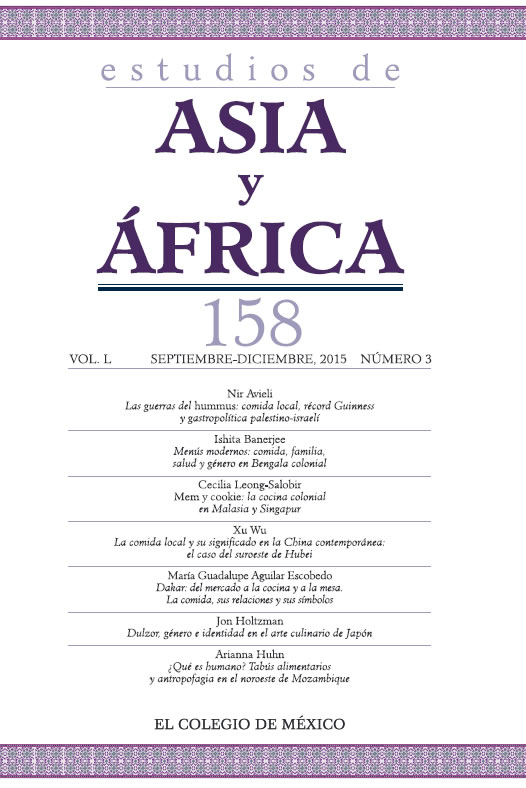Abstract
This paper examines confectionary as a pervasive, though relatively little discussed, aspect of contemporary and historical Japanese culinary culture. Sweets in their contemporary form trace their origins to courtly cuisine that entered Japanese food culture via contact with Portuguese traders in the 16th century. Certain types of sweets were present prior to this period, which appear to be at least in part influenced by contact with Chinese culture, though these were quite different from those that followed Portuguese contact. Sweets developed in this time period are viewed as intrinsically Japanese (wagashi) while ones that entered after the Meiji Reformation of the mid-19th century, and with greater intensity since World War II, are marked as European sweets (yogashi).
Archetypal wagashi are intricately handcrafted sweets made exclusively of local Japanese ingredients, shaped in visually beautiful forms that vary in form in order to be in tune with the changing seasons, and used most importantly in the tea ceremony. Western confectionary includes European cakes, pastries, and chocolate. These different types of sweets may be placed in a range of different categories, varying according to contrasting distinctions such as Japanese versus foreign and expensive/high class sweets versus cheaper, more everyday varieties. These distinctions are not completely exclusive, however, and other factors can also play a role in defining the uses and meanings of particular types of sweets. The many uses of sweets are to a great extent governed by the varying meanings of different sweets that are largely shared by the Japanese but also differ on account of factors such as age, gender, wealth, and self-positioning in regard to a traditionalist or modernist stance.
Sweets, both “Japanese” and “European”, have become important for daily consumption and for ritualized occasions. Sweets are, moreover, the quintessential gift in a culture in which gift-giving is a fundamental component of social relations, particularly the pervasive practice of giving omiyage—gifts representing a place to which one has travelled. In this practice, sweets feature as the most common and important gift. Sweets are used to mark local identities and are also highly gendered, with confectionary traditionally being the purview of women and children, although this has been reworked in intriguing ways in contemporary Japan. The most vivid example of gift-giving that is also gendered is provided by the practice carried out on the adopted holiday of Valentine’s Day. On this day, chocolate is given exclusively by women to men, sometimes as a social requirement (giri choco, obligation chocolate) to male co-workers and acquaintances as well as to one’s actual romantic interest (honmei choco, “true chocolate”). Through an exploration of a variety of sweets and their wide-ranging uses and meanings in local identities, gift exchange and gender relations, the paper aims not only to throw light on this key aspect of Japanese culinary culture, but also to use sweets as a window into broader aspects of Japanese life.
References
Ashkenazi, Michael y Jeanne Jacobs, The Essence of Japanese Cuisine, Filadelfia, University of Pennsylvania Press, 2000.
Ashkenazi, Michael y Jeanne Jacobs, Food Culture in Japan, Westport, Greenwood Press, 2003.
Bestor, Theodore, Tsukiji: Fish Market at the Center of the World, Berkeley, University of California Press, 2004.
Cwiertka, Katarzyna, Modern Japanese Cuisine, Londres, Reaktion Books, 2006.
Doi, Takeo, Understanding Amae: The Japanese Concept of Need-Love. Collected Papers of Japanese Writes on Japan Vol. 1, Kent, Global Oriental, 2005.
Hasegawa, Sayaka, “Metonymy in the Words for Taste Amai and Sweet”, Tokyo University Linguistic Papers, vol. 27, octubre de 2008, pp. 1-13.
Hobsbawm, E., “Introduction: Inventing Traditions”, en E. Hobsbawm y T. Ranger (eds.), The Invention of Tradition, Cambridge, Cambridge University Press, 1983, pp. 1-14.
Holtzman, Jon, Uncertain Tastes: Memory, Ambivalence and the Politics of Eating in Samburu, Northern Kenya, Berkeley, University of California Press, 2009.
Ishige, Naomichi, The History and Culture of Japanese Food, Londres, Routledge, 2001.
Laver, Michael, The Sakoku Edicts and the Politics of Tokugawa Hegemony, Londres, Cambria Press, 2011.
Mintz, Sidney, Sweetness and Power, Nueva York, Penguin, 1985.
Ohnuki-Tierney, E., Rice as Self: Japanese Identities through Time, Princeton, Princeton University Press, 1993.
Rath, Eric, Food and Fantasy in Early Modern Japan, Berkeley, University of California Press, 2010.
Sutton, David, “Food and the Senses”, Annual Review of Anthropology, vol. 39, 2010, pp. 209-223.
Yotova, Maria, “‘Bulgaria: The Holy Land of Yogurt’: A Brand Myth and Management Philosophy”, Senri Ethnological Studies, núm. 82, 2013, pp. 87-98.
This work is licensed under a Creative Commons Attribution-NonCommercial-NoDerivatives 4.0 International License
Copyright 2022 Estudios de Asia y África


